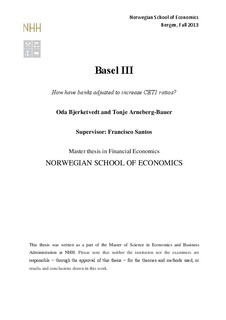Basel III : how have banks adjusted to increase CET1 ratios?
Master thesis
Permanent lenke
http://hdl.handle.net/11250/217080Utgivelsesdato
2013Metadata
Vis full innførselSamlinger
- Master Thesis [4372]
Sammendrag
In 2010 the Basel Committee finalised the global framework called Basel III, which will have a significant impact on the global banking sector. A large part of the framework focuses on capital adequacy, where the Common Equity Tier 1 (CET1) ratio is essential. Through an analysis of four banks from the United Kingdom – HSBC, Barclays, Lloyds Banking Group and Standard Chartered – this thesis aim to examine how these banks have adjusted to the new CET1 requirements.
In the EU the Basel III framework will be implemented through the capital requirements directive (CRD IV), and in 2012 our sample banks estimated their CET1 ratios assuming fully implemented CRD IV. We project the CET1 ratios for previous years and find that they have increased this ratio, especially from 2006. This thesis shows that adjustments have been made in both the numerator (CET1) and the denominator, risk weighted assets (RWA). CET1 has strengthened due to better quality and increased quantity of equity. However, the main driver behind the increase in the ratios has been a reduction of risk weighted assets. In general, the average riskiness of asset portfolios has been reduced through management actions on the balance sheet.
We also find that the impact of Basel III on our sample banks is heterogeneous because of banks’ differences regarding business structures and international exposure. The banks will also face different CET1 requirements after the transitional period. We project the 2019 final CET1 ratio requirement for each bank, and they all face a shortfall given a reasonable set of assumptions. This implies that the banks’ management still have to increase their CET1 ratios.
